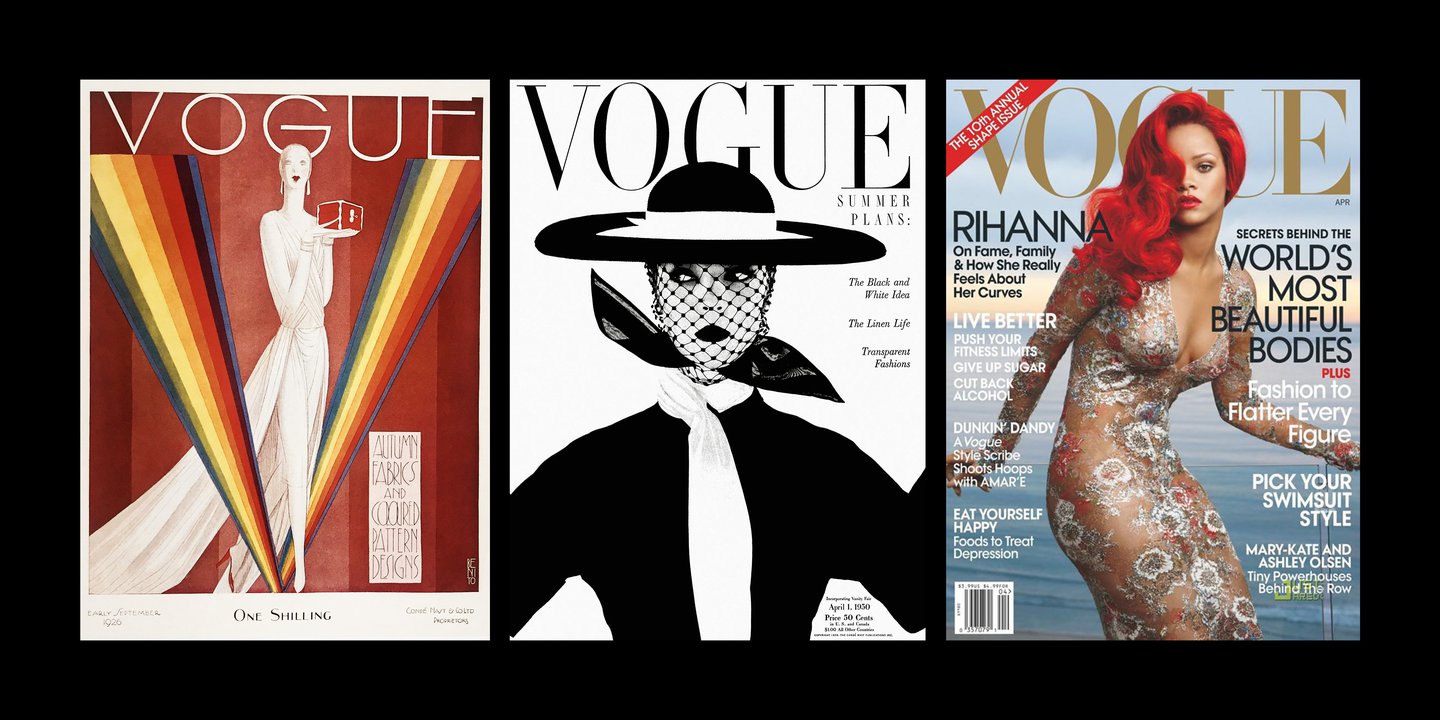
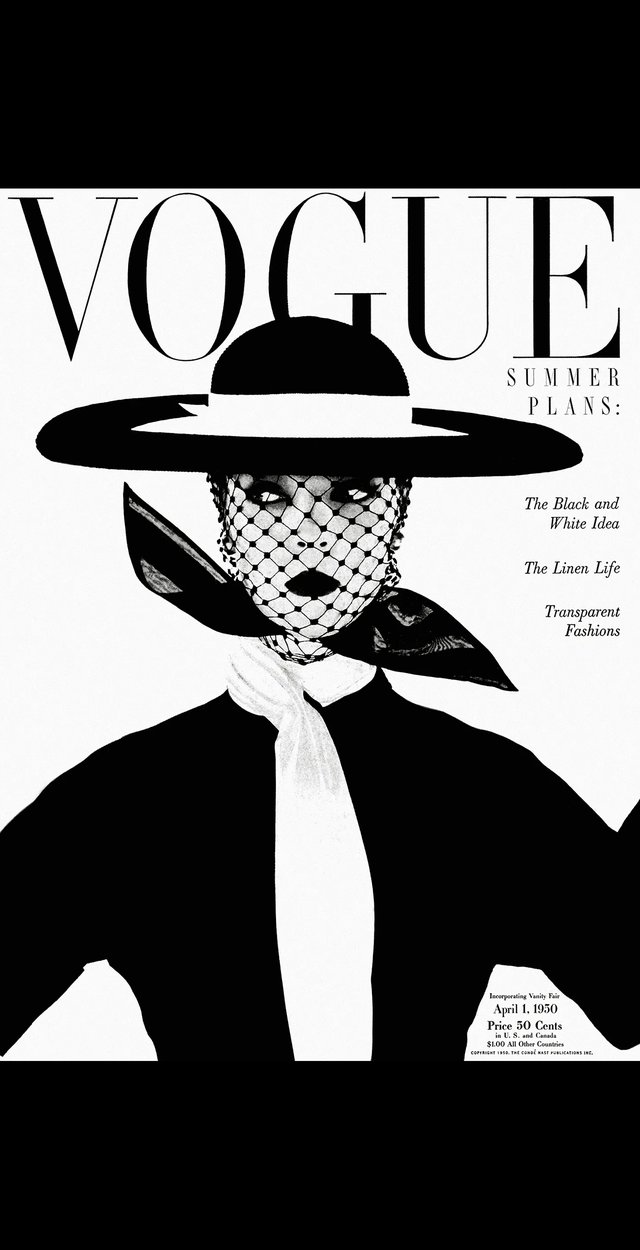
→
Scroll to discover more
Luxury is a drug
The story of Vogue
In 1909, a well-dressed man bought a modest little magazine at a newsstand in New York.
Nothing remarkable in that. Except that the man's name was Condé Nast and the flimsy newssheet was called "Vogue".
125 years later Vogue is published in 25 territories, has an international print readership of more than 25,000,000 every month, about 120 million online users and twice that number on social media. It is unquestionably the most authoritative commentator on the most fickle of industries: fashion. McKinsey value the fashion business today at around $2.7 trillion. Yet there are still people who refuse to take Vogue seriously - who think it's something frivolous. They clearly have no judgement and, obviously, no taste.
But the man who made Vogue everything it became was Condé Montrose Nast. Today Condé Nast is a multinational publishing corporation, but in 1909 it was just the name of an invisible young publisher with huge ambitions.
Nothing remarkable in that. Except that the man's name was Condé Nast and the flimsy newssheet was called "Vogue".
125 years later Vogue is published in 25 territories, has an international print readership of more than 25,000,000 every month, about 120 million online users and twice that number on social media. It is unquestionably the most authoritative commentator on the most fickle of industries: fashion. McKinsey value the fashion business today at around $2.7 trillion. Yet there are still people who refuse to take Vogue seriously - who think it's something frivolous. They clearly have no judgement and, obviously, no taste.
But the man who made Vogue everything it became was Condé Montrose Nast. Today Condé Nast is a multinational publishing corporation, but in 1909 it was just the name of an invisible young publisher with huge ambitions.
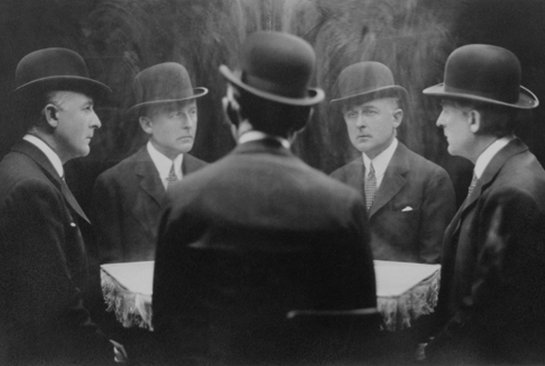
Before it was a brand, it was a man. Montrose Condé Nast.
Elegantly voracious, he was a social climber on a Himalayan scale. He made a fortune, and spent two. In later life a signature was the dove grey fedora: he had them sent from Borsalino in Milan and it was said that he only wore them once. He invented 'café society' - the thing, not the phrase. That was coined by a guest at one of the parties in his 30 room penthouse at 1040 Park Avenue, where victims had to run the gauntlet of Dorothy Parker on a chaise longue. He was the perfect person to create the greatest fashion magazine the world has ever seen and that's exactly what he did.
When Condé Nast picked up a copy of Vogue he immediately saw the potential. He was already becoming aware of a trend that he thought was going to be huge.
Fashion.
When Condé Nast picked up a copy of Vogue he immediately saw the potential. He was already becoming aware of a trend that he thought was going to be huge.
Fashion.
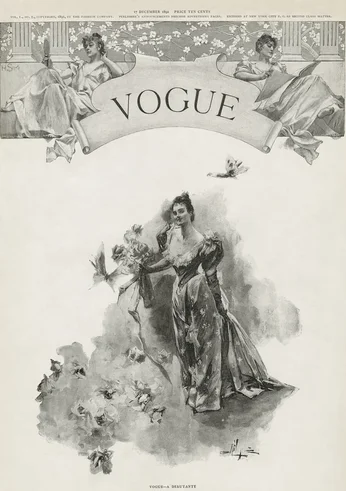
Before
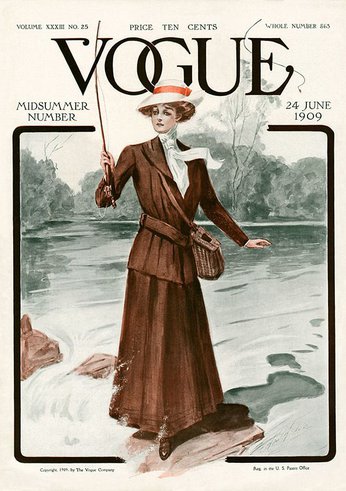
Condé Nast buys Vogue
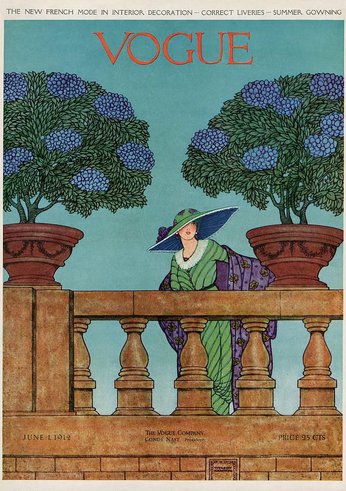
After
Of course fashion existed before, but only for a tiny elite, the ladies who could have a new gown made for every season. But that was changing. Automation was making clothes cheaper. A few visionaries had started to dream of something called mass fashion.
New York was the perfect place for this to take hold. Fashion was invented for cities. It's an urban thing. If you live in a small town or village, you won't impress by showing up in Chanel. But in a city of strangers, the rules are different. People come to cities to reinvent themselves and fashion is a brush that can paint a convincing picture.
Condé Montrose Nast knew he was in a city of dreamers. Millions of people all trying to imagine a better life. And a glossy magazine could give them a beautiful window into the world that they wanted to inhabit. From this unlikely little chrysalis in his hands at the newsstand he could conjure the butterfly that would be Vogue. In 1909 he bought the magazine and the two tiny rooms it was published from. Nothing was ever the same again.
The business of Vogue is brands and Vogue itself has become one of the most powerful brands in the world.
New York was the perfect place for this to take hold. Fashion was invented for cities. It's an urban thing. If you live in a small town or village, you won't impress by showing up in Chanel. But in a city of strangers, the rules are different. People come to cities to reinvent themselves and fashion is a brush that can paint a convincing picture.
Condé Montrose Nast knew he was in a city of dreamers. Millions of people all trying to imagine a better life. And a glossy magazine could give them a beautiful window into the world that they wanted to inhabit. From this unlikely little chrysalis in his hands at the newsstand he could conjure the butterfly that would be Vogue. In 1909 he bought the magazine and the two tiny rooms it was published from. Nothing was ever the same again.
The business of Vogue is brands and Vogue itself has become one of the most powerful brands in the world.
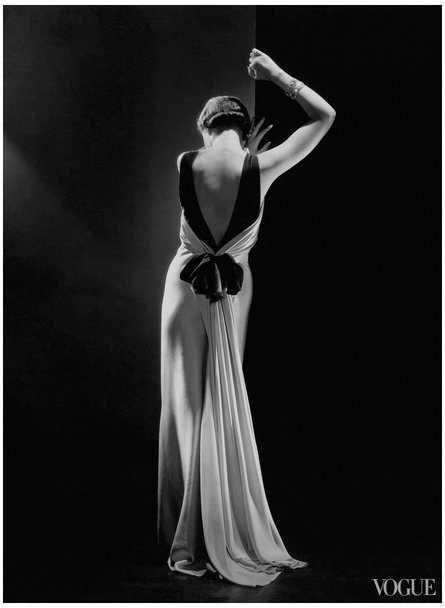
"A fashion photograph is not a photograph of a dress; it is a photograph of a woman" - Alexander Liberman, art director
It has survived world wars, revolutions, the disintegration of social class, the rise of feminism, the digital revolution and the emergence of woke culture. It has outperformed, or simply outlasted, every competitor.
What is really startling is that in 130 years American Vogue - the mother of all Vogues - has had only had seven editors.
Josephine Redding 1892 - 1901
Marie Harrison 1901 - 1914
Edna Woolman Chase 1914 - 1952
Jessica Daves 1953 - 1962
Diana Vreeland 1963 - 1971
Grace Mirabella 1971 - 1988
Anna Wintour 1988 -
To understand the extraordinary success of this brand, we can look at two of these remarkable women.
What is really startling is that in 130 years American Vogue - the mother of all Vogues - has had only had seven editors.
Josephine Redding 1892 - 1901
Marie Harrison 1901 - 1914
Edna Woolman Chase 1914 - 1952
Jessica Daves 1953 - 1962
Diana Vreeland 1963 - 1971
Grace Mirabella 1971 - 1988
Anna Wintour 1988 -
To understand the extraordinary success of this brand, we can look at two of these remarkable women.
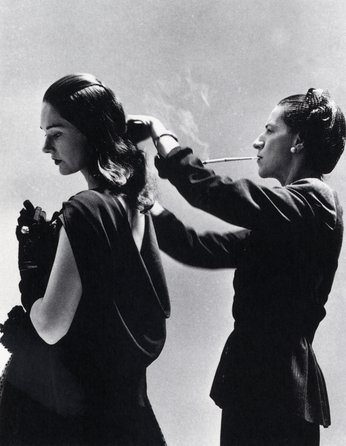
Doe Avedon and Diana Vreeland
Diana Vreeland. 1963-71.
These were the 60s. The days of revolution and the birth of the counterculture. It is hard to imagine anyone less suited to the role of editor of Vogue in these times than Diana Vreeland. Yet she became one of the great ones.
DV was born to a very grand family in Paris. In a sepia photograph of the Bois De Boulogne the chances are some of these ladies in crinolines and parasols will be relatives of DV. Someone once said that she had been born in the Belle Epoque but the problem was that no one had dared to tell her it was over.
If any woman in the world deserves to be described as absolutely fabulous, it would have to be DV.
For years she had a legendary "Why Don't You...?" column in Harper's Bazaar that perfectly expressed her world view.
These were the 60s. The days of revolution and the birth of the counterculture. It is hard to imagine anyone less suited to the role of editor of Vogue in these times than Diana Vreeland. Yet she became one of the great ones.
DV was born to a very grand family in Paris. In a sepia photograph of the Bois De Boulogne the chances are some of these ladies in crinolines and parasols will be relatives of DV. Someone once said that she had been born in the Belle Epoque but the problem was that no one had dared to tell her it was over.
If any woman in the world deserves to be described as absolutely fabulous, it would have to be DV.
For years she had a legendary "Why Don't You...?" column in Harper's Bazaar that perfectly expressed her world view.
“Why don’t you… rinse your blond child’s hair in dead champagne to keep it gold, as they do in France?”
“Why don’t you… have an elk-hide trunk for the back of your car? Hermès of Paris will make one for you.”
"Why don't you bring back from Central Europe a huge white baroque porcelain stove to stand in your front hall?"
“Why don’t you… have an elk-hide trunk for the back of your car? Hermès of Paris will make one for you.”
"Why don't you bring back from Central Europe a huge white baroque porcelain stove to stand in your front hall?"
She wrote her columns by hand in emerald green Chinese ink. She despised typewriters.
"Has anyone ever written a great love letter on a typewriter? A great suicide note?”
S I Newhouse, the publisher, described her as "The most provocative, imaginative, extravagant, uncontrollable, and spendthrift of all editors ever thrown at Vogue."
"Thrown" was the word. From the minute she arrived, she was a revolution. Vogue stood for taste and she thought that was just another word for dull. She wanted to see wonderful models in exotic places. Russian models in Cairo, beautiful French hippies in Afghanistan. It was a time of exploration, and this was five-star exploration.
She had her office lacquered Chinese red - she call it 'adulterous' red - with a faux leopard floor. She usually appeared around noon. Ish. And from then on the editors and assistants battled with a blizzard of searing green notes.
"Has anyone ever written a great love letter on a typewriter? A great suicide note?”
S I Newhouse, the publisher, described her as "The most provocative, imaginative, extravagant, uncontrollable, and spendthrift of all editors ever thrown at Vogue."
"Thrown" was the word. From the minute she arrived, she was a revolution. Vogue stood for taste and she thought that was just another word for dull. She wanted to see wonderful models in exotic places. Russian models in Cairo, beautiful French hippies in Afghanistan. It was a time of exploration, and this was five-star exploration.
She had her office lacquered Chinese red - she call it 'adulterous' red - with a faux leopard floor. She usually appeared around noon. Ish. And from then on the editors and assistants battled with a blizzard of searing green notes.
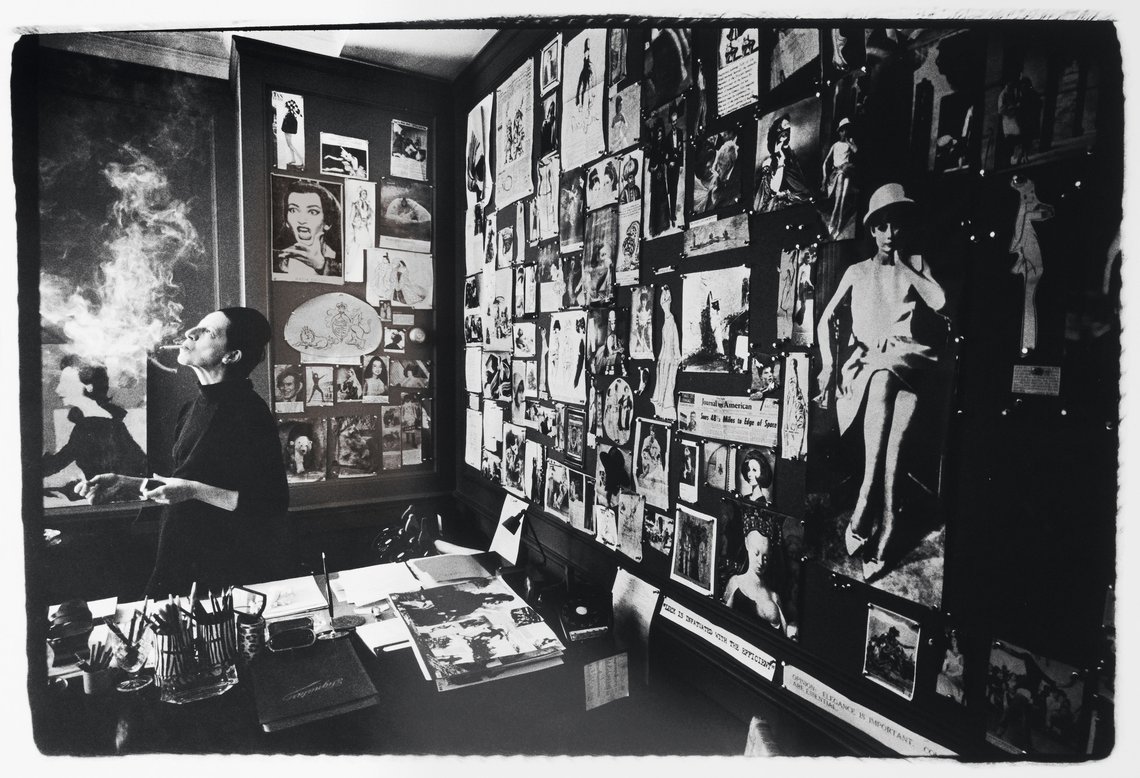
The answer is in the clouds. DV at work, 1965
"The bikini is the most important thing since the atom bomb."
"Unshined shoes are the end of civilisation."
'We're not here to give people what they want. We're here to give them what they don't know they want yet."
(Some think Steve Jobs said that, which he did, but thirty years later).
"High style can often be found in low places."
"Everybody is experimenting with drugs, but the most beautiful drug of all is luxury."
For all the grand manner and self-parody, she had a keen eye and loved new ideas.
"Be exactly what they expect, then constantly surprise them."
On her glossy pages she launched Twiggy, the first adolescent supermodel. An overnight sensation.
The miniskirt is often credited to Mary Quant or Yves St Laurent, but actually came from street fashion in Manchester. DV had Berry Berenson photograph her sister Marissa walking down the street in a YSL version. It was a sensational image.
Vogue had taken high fashion out of the studio and into the world.
"Unshined shoes are the end of civilisation."
'We're not here to give people what they want. We're here to give them what they don't know they want yet."
(Some think Steve Jobs said that, which he did, but thirty years later).
"High style can often be found in low places."
"Everybody is experimenting with drugs, but the most beautiful drug of all is luxury."
For all the grand manner and self-parody, she had a keen eye and loved new ideas.
"Be exactly what they expect, then constantly surprise them."
On her glossy pages she launched Twiggy, the first adolescent supermodel. An overnight sensation.
The miniskirt is often credited to Mary Quant or Yves St Laurent, but actually came from street fashion in Manchester. DV had Berry Berenson photograph her sister Marissa walking down the street in a YSL version. It was a sensational image.
Vogue had taken high fashion out of the studio and into the world.
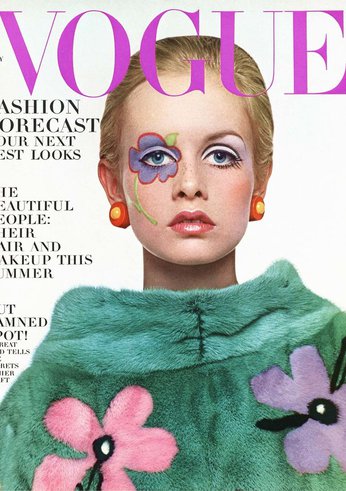
Twiggy shot by Richard Avedon, 1967
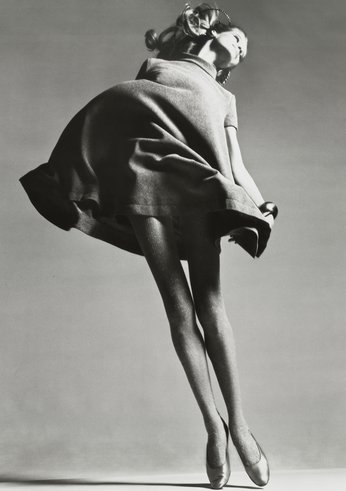
Veruschka shot by Richard Avedon, 1967
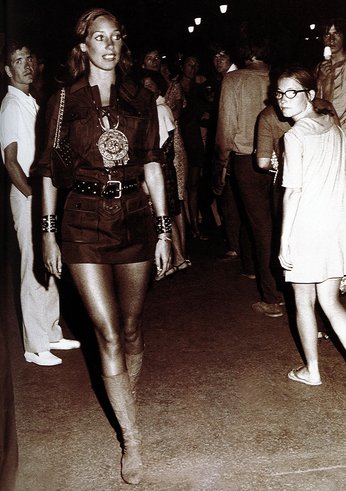
Marissa Berenson shot by her sister Berry, 1969
It was said that DV didn't know what anything cost, but that didn't matter because she didn't care.
She paid $1 million to attract the photographer Richard Avedon from Harper's Bazaar. And this was the 'Sixties, when a million was a million.
The same Richard Avedon had a hat carried from New York to the Alps. This frail feathery fantasy was four feet wide and travelled in a specially constructed box. It went by air, by car, by Jeep and ended up on a stretcher between two porters. When it reached its final destination, at 4000 metres, a spirit level was used to place it perfectly on the flawless head of the Russian supermodel Veruschka, which added a couple of metres to its elevation. When the shot got back to New York, DV threw it in the bin. She didn't care for the clouds.
The English photographer David Bailey, who shot for her all through the 'Sixties, said
"She was impossible. Everybody who loved her wanted to kill her."
But then the ‘60s became the ‘70s and overnight everything changed. All of a sudden it all looked too much. The helicopters. The hot air balloons. The chartered trains. The elephants. The sheer exotic madness of it all didn't fit with the pinched realities of the ‘70s. The party was over. DV was unceremoniously fired. (Straight to the Metropolitan Museum, where she turned the costume department into the most exciting fashion museum in the world. Better than anything in Paris or Milan).
Her replacement was Grace Mirabella, at Vogue for almost 20 years. She calmed everything down and professionalised the whole operation, turning it into a commercial success. The red lacquered office was repainted in her favourite colour which was, unfortunately, beige. As a reward for creating a calm working atmosphere and an expanding business, her tenure is still referred to as “The Beige Years”. In the fashion world the claws are never fully retracted.
Regime change at Vogue can be as brutal and as final as any coup. Grace Mirabella had been editor of Vogue for 17 successful years when she got home one night to find her husband watching television. He told her it was on the news that she had been fired. She called the publisher, S I Newhouse, who confirmed that “as of this afternoon” Anna Wintour was editor of Vogue.
Anna Wintour. 1988 -
Anna Wintour wouldn't have been everyone's choice. In fact, within Vogue she wouldn't have been anyone's choice. Her CV was patchy, with her most recent editorship, of House and Garden, a very public failure. Her interpersonal skills were captured in the nickname Nuclear Wintour, which makes her shudder to this day.
But this is the role she was born for. Her father was a legendary newspaper editor who told Anna when she was 10 that she would one day be the editor of Vogue. She never doubted it. And she never forgot his advice: know more than anyone else knows and never let them forget it.
She also listened to friends, especially Karl Lagerfeld. The Kaiser despised grey. Wouldn’t wear it. For those who know what they’re doing, the world is black and white.
She paid $1 million to attract the photographer Richard Avedon from Harper's Bazaar. And this was the 'Sixties, when a million was a million.
The same Richard Avedon had a hat carried from New York to the Alps. This frail feathery fantasy was four feet wide and travelled in a specially constructed box. It went by air, by car, by Jeep and ended up on a stretcher between two porters. When it reached its final destination, at 4000 metres, a spirit level was used to place it perfectly on the flawless head of the Russian supermodel Veruschka, which added a couple of metres to its elevation. When the shot got back to New York, DV threw it in the bin. She didn't care for the clouds.
The English photographer David Bailey, who shot for her all through the 'Sixties, said
"She was impossible. Everybody who loved her wanted to kill her."
But then the ‘60s became the ‘70s and overnight everything changed. All of a sudden it all looked too much. The helicopters. The hot air balloons. The chartered trains. The elephants. The sheer exotic madness of it all didn't fit with the pinched realities of the ‘70s. The party was over. DV was unceremoniously fired. (Straight to the Metropolitan Museum, where she turned the costume department into the most exciting fashion museum in the world. Better than anything in Paris or Milan).
Her replacement was Grace Mirabella, at Vogue for almost 20 years. She calmed everything down and professionalised the whole operation, turning it into a commercial success. The red lacquered office was repainted in her favourite colour which was, unfortunately, beige. As a reward for creating a calm working atmosphere and an expanding business, her tenure is still referred to as “The Beige Years”. In the fashion world the claws are never fully retracted.
Regime change at Vogue can be as brutal and as final as any coup. Grace Mirabella had been editor of Vogue for 17 successful years when she got home one night to find her husband watching television. He told her it was on the news that she had been fired. She called the publisher, S I Newhouse, who confirmed that “as of this afternoon” Anna Wintour was editor of Vogue.
Anna Wintour. 1988 -
Anna Wintour wouldn't have been everyone's choice. In fact, within Vogue she wouldn't have been anyone's choice. Her CV was patchy, with her most recent editorship, of House and Garden, a very public failure. Her interpersonal skills were captured in the nickname Nuclear Wintour, which makes her shudder to this day.
But this is the role she was born for. Her father was a legendary newspaper editor who told Anna when she was 10 that she would one day be the editor of Vogue. She never doubted it. And she never forgot his advice: know more than anyone else knows and never let them forget it.
She also listened to friends, especially Karl Lagerfeld. The Kaiser despised grey. Wouldn’t wear it. For those who know what they’re doing, the world is black and white.
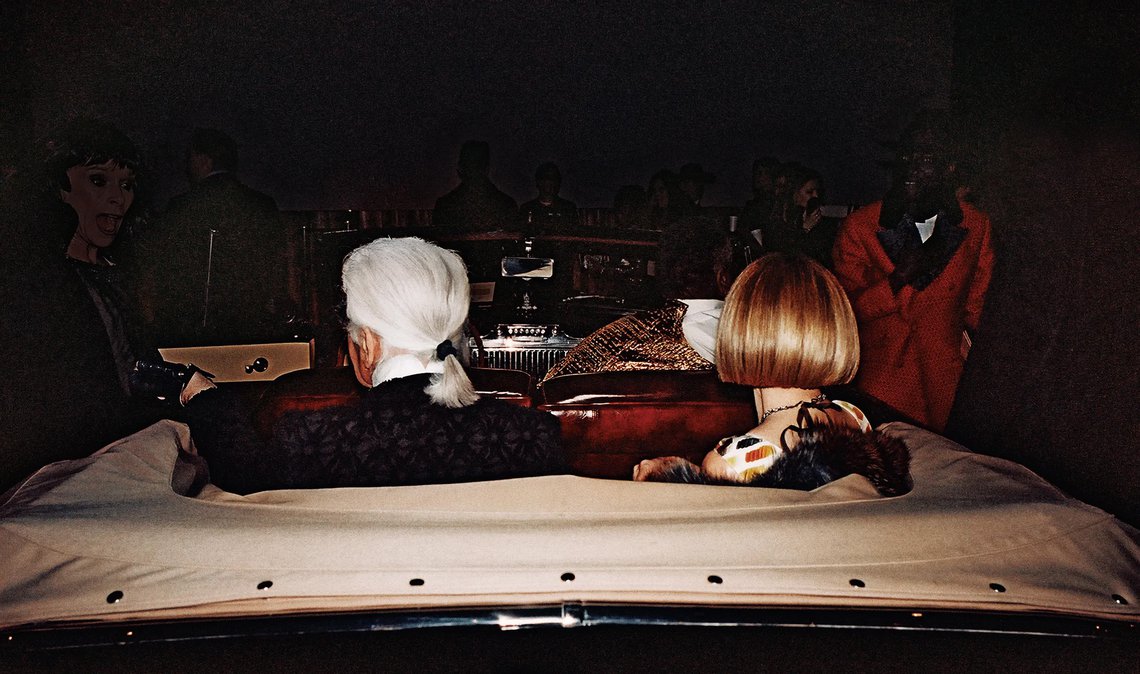
On the town. Karl and Anna, 2013
“Fashion is fear. People are afraid of buying the wrong things, of wearing the wrong things. You are the editor. They need to know that you know. The minute they think you don’t know, it’s over. You have committed suicide. Worse than that, you’ve killed your magazine. You’ve killed something much older than you are, much more valuable than you are, and much more beautiful than you are.”
Fashion is armour and Anna's cloak of invisibility is perfection. She is never less than flawless. There are no chinks. The hair is a helmet, the indoor sunglasses a visor. A Starbucks venti skinny latte is locked in her right hand, but she never drinks more than an inch. Her left hand is for pointing. Life is a joust and the catwalks are the lists.
Anna doesn’t walk into a room, Vogue walks in.
"I want ‘Vogue’ to be pacy, sharp, and sexy – I’m not interested in the super-rich or infinitely leisured. I want our readers to be energetic executive women, with money of their own and a wide range of interests. There is a new kind of woman out there. She’s interested in business and money.”
Fashion is armour and Anna's cloak of invisibility is perfection. She is never less than flawless. There are no chinks. The hair is a helmet, the indoor sunglasses a visor. A Starbucks venti skinny latte is locked in her right hand, but she never drinks more than an inch. Her left hand is for pointing. Life is a joust and the catwalks are the lists.
Anna doesn’t walk into a room, Vogue walks in.
"I want ‘Vogue’ to be pacy, sharp, and sexy – I’m not interested in the super-rich or infinitely leisured. I want our readers to be energetic executive women, with money of their own and a wide range of interests. There is a new kind of woman out there. She’s interested in business and money.”
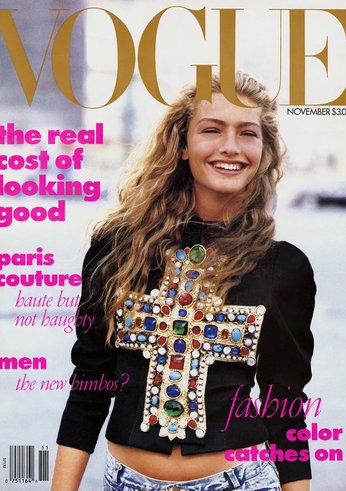
Jeans and a $4000 sweater
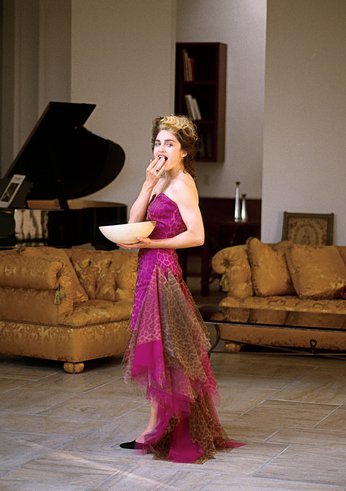
The future belongs to celebrities
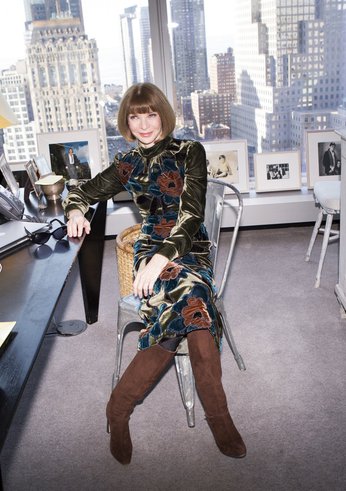
Anna at One World Trade Center
Anna Wintour took on Vogue at a critical time. All the signs were bad. Digital was coming and the death of print was being hysterically proclaimed, ironically enough, in magazines and newspapers. Print was over and so was retail. Digital would do everything from advertising to shopping, so magazines and bricks and mortar stores were just relics of our crumbling past.
Very few people could see it at the time, but luxury was about to change dramatically. It was about to go from the preserve of a tiny elite, with discreet shops in exclusive streets, to a full-scale mass market presence, highly visible in department stores, airports and online.
When Anna was appointed in 1988 Bernard Arnault had bought the Christian Dior brand for a ceremonial one franc. The great traditional luxury brands, some still family businesses, simply could not see a future. They could not imagine a way to stay relevant. Arnault began his journey to become the richest man in the world by betting that there was a mass audience for these rarefied names.
Along the way his most trusted advisor has been Anna Wintour. He wouldn’t make a key appointment without her approval. John Galliano, Alexander McQueen and Marc Jacobs were all Anna’s boys.
So Anna was at the heart of the dramatic process of reinventing and redefining these iconic brands. But that still left her with the issues around her own brand, the magazine Vogue.
She knew she had to do something to give the brand longevity and relevance. Perhaps it was even the time to think about a life after print. The term “experiential marketing” wasn't yet widely used, but she immediately created one of the classic examples without waiting for the theorists to catch up.
When Anna looked at the Met Ball she saw the potential for a perfect storm.
Very few people could see it at the time, but luxury was about to change dramatically. It was about to go from the preserve of a tiny elite, with discreet shops in exclusive streets, to a full-scale mass market presence, highly visible in department stores, airports and online.
When Anna was appointed in 1988 Bernard Arnault had bought the Christian Dior brand for a ceremonial one franc. The great traditional luxury brands, some still family businesses, simply could not see a future. They could not imagine a way to stay relevant. Arnault began his journey to become the richest man in the world by betting that there was a mass audience for these rarefied names.
Along the way his most trusted advisor has been Anna Wintour. He wouldn’t make a key appointment without her approval. John Galliano, Alexander McQueen and Marc Jacobs were all Anna’s boys.
So Anna was at the heart of the dramatic process of reinventing and redefining these iconic brands. But that still left her with the issues around her own brand, the magazine Vogue.
She knew she had to do something to give the brand longevity and relevance. Perhaps it was even the time to think about a life after print. The term “experiential marketing” wasn't yet widely used, but she immediately created one of the classic examples without waiting for the theorists to catch up.
When Anna looked at the Met Ball she saw the potential for a perfect storm.
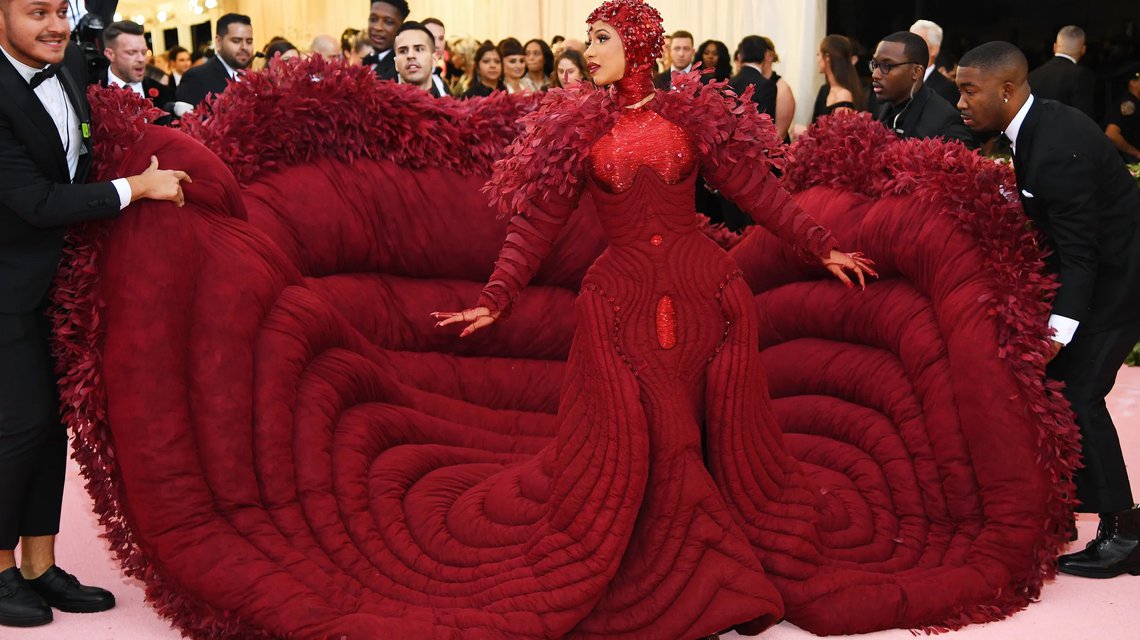
Cardi B's menstruating gown, 2019
She could see that the future was about celebrities. She was already experimenting with actresses and singers (the first was Madonna) on the cover of Vogue, a space traditionally reserved for models, with a very rare exception made for royalty or a First Lady. Celebrities were joining aristocrats and billionaires on the A list. An Oscar had the social currency of an inherited title. A reality show celeb could attract more column inches than a minor royal.
And then there was Art. With a cap A.
In luxury, ”Art” was the coming thing. The old story was that luxury goods were better because they were created by craftspeople working with the finest materials in ateliers that had been around for generations. Now that the world could see the stuff was produced by huge factories in China, that story wouldn't wash any more. And, anyway, a Marc Jacobs patchwork denim handbag from Louis Vuitton hardly sings of traditional craft. If the mystique couldn't come from tradition it would have to come from someplace else. ”Art” was the perfect place. Aloof, mysterious, with its own special codes that are only understood by an elite cognoscenti, art was the perfect environment for luxury goods. They could even, with some skilful publicity, pass themselves off as works of art.
And here was a chance to bring it all together in the most prestigious art venue in America in a grand, formal, totally exclusive event that the whole world would want to see. Baz Luhrmann described the Met Ball as "an aquarium": a sprinkling of ancient titles, a light dusting of star designers, and a generous helping of celebrities, celebrities, celebrities. Actors, singers, models. The beautiful people. In the most beautiful clothes. It's the Super Bowl of the fashion world.
And then there was Art. With a cap A.
In luxury, ”Art” was the coming thing. The old story was that luxury goods were better because they were created by craftspeople working with the finest materials in ateliers that had been around for generations. Now that the world could see the stuff was produced by huge factories in China, that story wouldn't wash any more. And, anyway, a Marc Jacobs patchwork denim handbag from Louis Vuitton hardly sings of traditional craft. If the mystique couldn't come from tradition it would have to come from someplace else. ”Art” was the perfect place. Aloof, mysterious, with its own special codes that are only understood by an elite cognoscenti, art was the perfect environment for luxury goods. They could even, with some skilful publicity, pass themselves off as works of art.
And here was a chance to bring it all together in the most prestigious art venue in America in a grand, formal, totally exclusive event that the whole world would want to see. Baz Luhrmann described the Met Ball as "an aquarium": a sprinkling of ancient titles, a light dusting of star designers, and a generous helping of celebrities, celebrities, celebrities. Actors, singers, models. The beautiful people. In the most beautiful clothes. It's the Super Bowl of the fashion world.
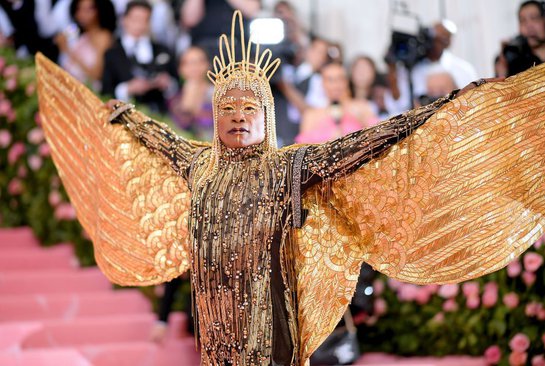
Billy Porter flies in, 2019
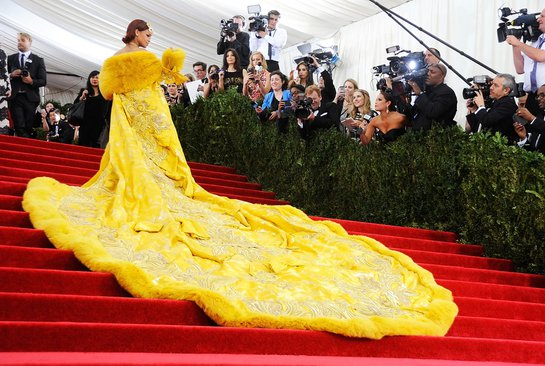
Rihanna owns the stares, 2015
The Met Gala red carpet is the most photographed staircase on the planet. Creations from celebrity designers, worn by the most luminous celebrities of the day, paraded amongst antique treasures from the ancient world.
And all summoned to this place by Vogue.
15 million tuned into the livestream. Vogue's social recorded 200 million views, with shares and virals the final figure could be ten times that.
It's experiential advertising. Everybody knows. And nobody has an issue with that. "There's a new kind of woman out there. She's interested in business and money." The participants even pay $30,000 just to take part. But don't waste your time thinking about saving, even if you had the money you wouldn't get in. The guest list, every single name on it, has to be approved by one person.
And all summoned to this place by Vogue.
15 million tuned into the livestream. Vogue's social recorded 200 million views, with shares and virals the final figure could be ten times that.
It's experiential advertising. Everybody knows. And nobody has an issue with that. "There's a new kind of woman out there. She's interested in business and money." The participants even pay $30,000 just to take part. But don't waste your time thinking about saving, even if you had the money you wouldn't get in. The guest list, every single name on it, has to be approved by one person.
"It May Be Called the Met Ball,
But It's Anna Wintour's Party."
But It's Anna Wintour's Party."
NY Times, May 3 2015
It's an extraordinary achievement. The costume department at the Met is funded by the gala. And hundreds of thousands of people queue up to see the exhibition that follows.
A glance at the website shows just how important this event has become. The Met is only closed on four days of the year: Thanksgiving, Christmas Day, New Year's Day and the first Monday in May.
Marketing is like music. Most of us blunder about and with a few lessons and enough practice can manage to get some kind of melody together. But there are a few rare and special people who just do it all instinctively, elegantly, and without apparent effort. Steve Jobs was one, Anna Wintour is another. They are naturals. They make it look easy and logical because, to them, it is.
They can sense a change before they see it coming. They don't need research to tell them, it's a feral instinct.
Anna Wintour has created a platform that will be essential to the future of the Vogue brand.
But she remains very committed to the tactile experience of the magazine and has icily ignored all pressures to cut down the weight and the cost by printing on lighter, less glossy, paper stock. "Vogue is about luxury and the magazine itself has to be a luxury."
As long as there is fashion, there will be Vogue.
A glance at the website shows just how important this event has become. The Met is only closed on four days of the year: Thanksgiving, Christmas Day, New Year's Day and the first Monday in May.
Marketing is like music. Most of us blunder about and with a few lessons and enough practice can manage to get some kind of melody together. But there are a few rare and special people who just do it all instinctively, elegantly, and without apparent effort. Steve Jobs was one, Anna Wintour is another. They are naturals. They make it look easy and logical because, to them, it is.
They can sense a change before they see it coming. They don't need research to tell them, it's a feral instinct.
Anna Wintour has created a platform that will be essential to the future of the Vogue brand.
But she remains very committed to the tactile experience of the magazine and has icily ignored all pressures to cut down the weight and the cost by printing on lighter, less glossy, paper stock. "Vogue is about luxury and the magazine itself has to be a luxury."
As long as there is fashion, there will be Vogue.
Featured stories
See all of our stories 